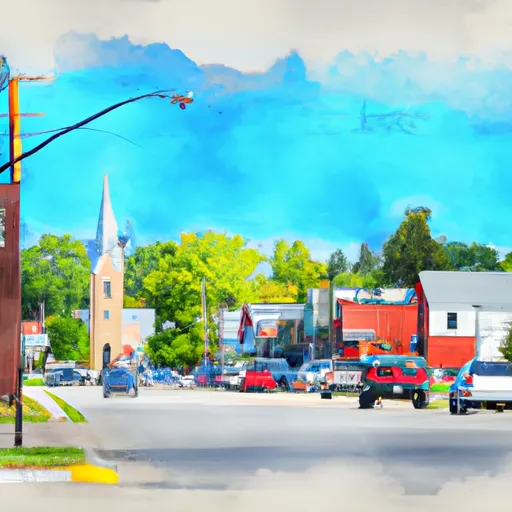-
 Snoflo Premium
Snoflo Premium
Get unlimited access to all our content
With no Ad interruptions! - Start Your Free Trial Login with existing account
Lennon
Eden Index
Climate
7.4
•
Recreation
2.2
•
Community
•
Safeguard
3.7/10

Lennon, Michigan is a small village located in Shiawassee County. The climate in Lennon is classified as humid continental, characterized by warm summers and cold, snowy winters. Average temperatures range from the mid-20s Fahrenheit in winter to the mid-70s in summer. The region experiences moderate rainfall throughout the year.
The village of Lennon is surrounded by beautiful natural landscapes, with several lakes and rivers in the vicinity. The hydrology constituents in the area include rivers like the Shiawassee River and Swartz Creek, which offer opportunities for kayaking, canoeing, and fishing. There are also several nearby lakes, such as Lake Victoria and Lake Manitou, where visitors can enjoy boating and swimming activities.
For outdoor enthusiasts, Lennon offers various recreational opportunities. The surrounding countryside is dotted with parks and nature reserves, providing ample space for hiking, picnicking, and wildlife observation. Nearby state parks, such as Sleepy Hollow State Park and Owosso City Park, offer additional recreational facilities, including campgrounds and trails for biking and walking.
In conclusion, Lennon, Michigan provides a picturesque setting with a pleasant climate, abundant water resources, and diverse outdoor recreation opportunities, making it an attractive destination for nature lovers and outdoor enthusiasts.
What is the Eden Index?
The Snoflo Eden Index serves as a comprehensive rating system for regions, evaluating their desirability through a holistic assessment of climate health, outdoor recreation opportunities, and natural disaster risk, acknowledging the profound impact of these factors on livability and well-being.
Climate Health Indicator (CHI): 7.4
Lennon receives approximately
813mm of rain per year,
with humidity levels near 82%
and air temperatures averaging around
9°C.
Lennon has a plant hardyness factor of
6, meaning
plants and agriculture in this region thrive during a short period during spring and early summer. Most
plants will die off during the colder winter months.
By considering the ideal temperature range, reliable water supplies, clean air, and stable seasonal rain or snowpacks, the Climate Health Indicator (CHI) underscores the significance of a healthy climate as the foundation for quality living.
A healthy climate is paramount for ensuring a high quality of life and livability in a region, fostering both physical well-being and environmental harmony. This can be characterized by ideal temperatures, reliable access to water supplies, clean air, and consistent seasonal rain or snowpacks.
Weather Forecast
Streamflow Conditions
Saginaw
Area Rivers
Saginaw
Snowpack Depths
Saginaw
Reservoir Storage Capacity
Saginaw
Groundwater Levels
Recreational Opportunity Index (ROI): 2.2
The Recreational Opportunity Index (ROI) recognizes the value of outdoor recreational options, such as parks, hiking trails, camping sites, and fishing spots, while acknowledging that climate plays a pivotal role in ensuring the comfort and consistency of these experiences.
Access to outdoor recreational opportunities, encompassing activities such as parks, hiking, camping, and fishing, is crucial for overall well-being, and the climate plays a pivotal role in enabling and enhancing these experiences, ensuring that individuals can engage in nature-based activities comfortably and consistently.
Camping Areas
| Campground | Campsites | Reservations | Toilets | Showers | Elevation |
|---|---|---|---|---|---|
| Appleton Lake - Brighton Rec Area | None | 888 ft | |||
| Bishop Lake - Brighton Rec Area | None | 901 ft | |||
| Murray Lake - Brighton Rec Area | None | 875 ft | |||
| Green Lake - Waterloo State Rec Area | None | 959 ft | |||
| Sugarloaf Lake - Waterloo State Rec Area | None | 961 ft | |||
| W. J. Hayes State Park | 185 | 1,001 ft | |||
| Pinckney State Rec Area | 235 | 907 ft | |||
| Mary Jane Thurston State Park | 35 | 644 ft |
Nearby Ski Areas
Catastrophe Safeguard Index (CSI):
The Catastrophe Safeguard Index (CSI) recognizes that natural disaster risk, encompassing floods, fires, hurricanes, and tornadoes, can drastically affect safety and the overall appeal of an area.
The level of natural disaster risk in a region significantly affects safety and the overall livability, with climate change amplifying these risks by potentially increasing the frequency and intensity of events like floods, fires, hurricanes, and tornadoes, thereby posing substantial challenges to community resilience and well-being.
Community Resilience Indicator (CRI):
The Community Resilience Indicator (CRI) recognizes that education, healthcare, and socioeconomics are crucial to the well-being of a region. The CRI acknowledges the profound impact of these elements on residents' overall quality of life. By evaluating educational resources, healthcare accessibility, and economic inclusivity, the index captures the essential aspects that contribute to a thriving community, fostering resident satisfaction, equity, and social cohesion.

